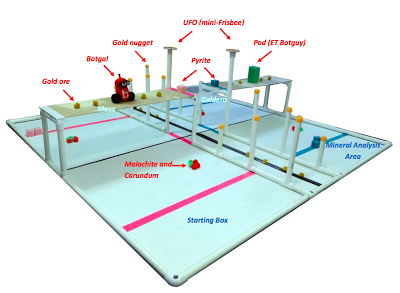One of the most anticipated thing for Botball Teams is learning about this year's game. Each year the game changes and presents different challenges and use of different skills. Typically, the Game is themed after the GCER (Global Conference on Educational Robotics) host location. This year, GCER will be in Albuquerque, New Mexico from July 7 - 11, 2015.
The game is always reviewed during the Hawaii Regional Workshop. However, most teams can't wait, and as soon as the documents become available your team should download them from their Team Home Base and get familiar with it. This typically occurs in Mid January and gives you a few weeks to go over it before the Hawaii Regional Workshop which typically occurs in the first or second weekend in February.
This is a picture of the 2015 Game Field. Everybody has downloaded the "2015 Botball Game Review v1.81.pdf" from their Team Home Base, right?
You want to start with "This Year's Game", which gives you the context of what is going on. Not necessarily super important but it provides a reason for why you are doing certain things. This year Botgal and her cousin are geologists conducting geological surveys on the two mesas between the mountains. It is also rumored that there are extra terrestrials in the area in search of gold ore and nuggets which may be found in the mountains and caves under them.
Teams want to then become familiar with "The Game Board Areas", "Game Pieces", and "Game Piece Starting Positions".
The Game Board Areas describes various portions of the Game Field. They are important because they identify scoring locations for objects or may have physical properties that become important in deciding how to build your robot. You also want to make sure you clearly understand what are the boundaries of a particular area. The 2015 Game has the following Game Board Areas: Starting Box, Mineral Analysis Area, Mesa, Cave, Caldera, and Mountain Peaks.
After being familiar with the various areas of the board, the team should then study the Game Pieces and their Starting Positions. In particular, you want to note where the objects are placed. Does an item always start in the same position? Is it's starting position randomly determined? Does the team get to choose where to place specific objects? Game pieces also have an effect on the type of manipulators (e.g. 'claw', 'scoop', etc) that are needed in the robot.
Once the team is familiar with the game areas, game pieces, and starting positions, then the team wants to study the "Scoring" and "Scoring Rules". Scoring is one of the most important parts of the Game and should be thoroughly reviewed. You need to know how many points are scored for an object under 'which' condition(s). Which are the high point items? This years game has Multipliers! These can magnify your points tremendously, but you have to know under which conditions do they apply.
Once you understand the Scoring, then you can really begin to discuss your strategy for the the Game.

No comments:
Post a Comment